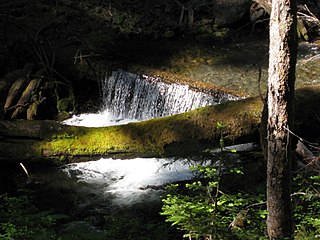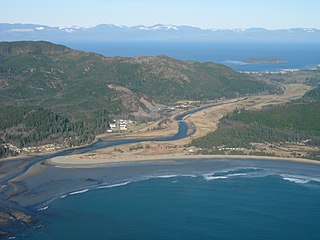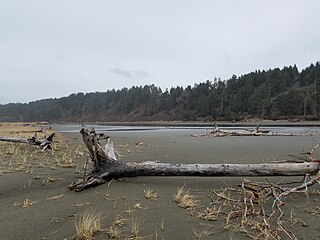
The Big Quilcene River is a river on the Olympic Peninsula in the U.S. state of Washington. It rises in the Buckhorn Wilderness near Marmot Pass, south of Buckhorn Mountain, and near Boulder Ridge. It flows generally east through the Olympic Mountains and the Olympic National Forest. After flowing south briefly the river is joined by Tunnel Creek and again flows east. It cuts through the Quilcene Range of the Olympic Mountains in which it collects a number of tributaries, including Mile And A Half Creek. Near Rainbow Campground the river turns north and is paralleled by U.S. Route 101. In its last few miles the river turns east and flows by the south side of Quilcene before emptying into Quilcene Bay, part of Hood Canal. The Little Quilcene River enters Quilcene Bay less than a mile to the north.

The Skokomish River is a river in Mason County, Washington, United States. It is the largest river flowing into Hood Canal, a western arm of Puget Sound. From its source at the confluence of the North and South Forks the main stem Skokomish River is approximately 9 miles (14 km) long. The longer South Fork Skokomish River is 40 miles (64 km), making the length of the whole river via its longest tributary about 49 miles (79 km). The North Fork Skokomish River is approximately 34 miles (55 km) long. A significant part of the Skokomish River's watershed is within Olympic National Forest and Olympic National Park.

The Quinault River is a 69-mile (111 km) long river located on the Olympic Peninsula in the U.S. state of Washington. It originates deep in the Olympic Mountains in the Olympic National Park. It flows southwest through the "Enchanted Valley" to opposite Quinault Canyon. Several miles above Lake Quinault the river is joined by its main tributary, the North Fork Quinault River. The main stem Quinault River above this confluence is sometimes called the East Fork Quinault River. Below the confluence the river marks the boundary of Olympic National Park for several miles before emptying into Lake Quinault. After the lake, the Quinault River flows southwest, reaching the Pacific at Taholah. From Lake Quinault to the ocean, the river is contained within the Quinault Indian Reservation.

Ozette Lake is the largest unaltered natural lake in Washington state at 29.5 km².

The Sol Duc River is a river in the U.S. state of Washington. About 78 miles (126 km) long, it flows west through the northwest part of the Olympic Peninsula, from the Olympic Mountains of Olympic National Park and Olympic National Forest, then through the broad Sol Duc Valley. Near the Pacific Ocean the Sol Duc River joins the Bogachiel River, forming the Quillayute River, which flows about 4 miles (6.4 km) to the Pacific Ocean at La Push. Although the Quillayute River is short, its large tributary rivers—the Sol Duc, Bogachiel, Calawah, and Dickey Rivers—drain the largest watershed of the northern Olympic Peninsula, 629 square miles (1,630 km2). The Sol Duc's watershed is the largest of the Quillayute's tributaries, at 219 square miles (570 km2).

The Little Quilcene River is a river on the Olympic Peninsula in the U.S. state of Washington. It rises in Clallam County, near Mount Townsend of the Olympic Mountains. The river flows generally east through the Olympic National Forest. After exiting the higher mountains and the national forest the Little Quilcene River flows east and southeast through rolling terrain. It enters Jefferson County and flows more directly south to Quilcene, where it empties into the northern end of Quilcene Bay, part of Hood Canal. The Big Quilcene River enters Quilcene Bay less than a mile to the south.

The Pysht River is a stream in the U.S. state of Washington. It originates near Ellis Mountain in the northern Olympic Mountains on the Olympic Peninsula and flows generally north, emptying into the Strait of Juan de Fuca. The Pysht and nearby Hoko River are the two largest streams flowing into the southwestern portion of the Strait of Juan de Fuca. The watershed of the Pysht River drains a region of industrial forest lands; 98% of the watershed is zoned commercial forestry and the remainder rural. Nearly all of the forests have been logged at least once and most trees are less than thirty years old. The upper portions of the watershed, which feature steep gradients, are owned by the United States Forest Service. The lower reaches, with low gradients, are largely owned by two industrial forest owners.

The Foss River is a stream in the U.S. state of Washington. It has two main forks, the East Fork Foss River and the West Fork Foss River. The main stem is formed by the confluence of the two forks. The river and its forks rise near in the Alpine Lakes Wilderness area of Mount Baker-Snoqualmie National Forest in the Cascade Mountains and flows generally north, joining the Tye River to form the South Fork Skykomish River. The Foss River's waters eventually empty into Puget Sound near Everett via the Skykomish River and Snohomish River.

The Tahuya River is a stream in the U.S. state of Washington. It originates at Tahuya Lake in western Kitsap Peninsula and flows south, emptying into Hood Canal near the Great Bend.

The Dewatto River is a stream in the U.S. state of Washington. It originates in western Kitsap Peninsula and flows south, emptying into Hood Canal. The name "Dewatto" comes from the Twana placename [duʔwátaxʷ], which implies the presence of spirits causing mental derangement near the stream's mouth.

The Union River is a stream in the U.S. state of Washington. It originates in central Kitsap Peninsula and flows south, emptying into the end of Hood Canal. The Union River Reservoir provides drinking water for the nearby city of Bremerton.

The East Twin River is a stream on the Olympic Peninsula in the U.S. state of Washington. It originates in the northern Olympic Mountains and flows north, emptying into the Strait of Juan de Fuca just east of West Twin River.

The West Twin River is a stream on the Olympic Peninsula in the U.S. state of Washington. It originates in the northern Olympic Mountains and flows north, emptying into the Strait of Juan de Fuca just east of East Twin River.

The Sail River is a stream on the Olympic Peninsula in the U.S. state of Washington. It originates in the northern Olympic Mountains and flows north, emptying into the Strait of Juan de Fuca.

The Waatch River is a stream on the Olympic Peninsula in the U.S. state of Washington. It originates in the northwestern Olympic Mountains and empties into the Pacific Ocean. The name "Waatch" comes from the Makah village name /waʔač'/, said to mean "bundling up cedar to make a torch".

The Sooes River is a stream on the Olympic Peninsula in the U.S. state of Washington. It originates in the northwestern Olympic Mountains and empties into the Pacific Ocean.

The Big River is a river on the Olympic Peninsula in the U.S. state of Washington. A principal tributary of the Ozette River, the Big River originates in the northwestern Olympic Mountains and empties into the Ozette Lake.

The Dickey River is a stream on the Olympic Peninsula in the U.S. state of Washington. It has three main forks, the East Fork, West Fork, and Middle Fork Dickey Rivers. The main stem is formed by the confluence of the East and West Forks. The river and its forks rise in the northwestern part of the Olympic Peninsula and flow generally south and west to join the Quillayute River near its mouth on the Pacific Ocean.

The Copalis River is a stream on the Olympic Peninsula in the U.S. state of Washington. It originates in the foothills on the southwest side of the Olympic Mountains and empties into the Pacific Ocean. The name "Copalis" comes from the Quinault language term /k'ʷpíls/. The Copalises are a Native American group. Both the Chehalis people and Quinault Indian Nation claim the Copalis are a subdivision of their tribe.

The Raft River is a stream located entirely within the Quinault Indian Reservation in Grays Harbor County, on the Olympic Peninsula, in the U.S. state of Washington. The river and its tributaries flow west from the Olympic Mountains and empty into the Pacific Ocean. It is situated a few miles north of the Quinault River and a few miles south of the Queets River.












